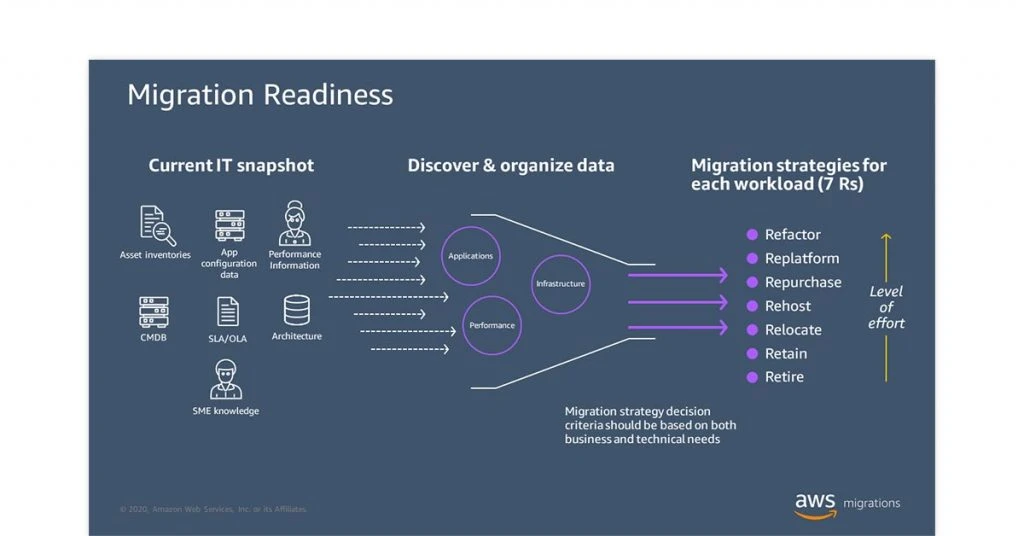How to Migrate on AWS Cloud Services (AWS): Steps to Successful Cloud Journey

As companies move to a hybrid work model after Covid-19 restrictions, the demand for cloud computing is increasing exponentially. According to a report from Markets and Markets Research, the cloud computing market size is estimated to grow from USD 445.3 billion in 2021 to USD 947.3 billion by 2026 at a CAGR of 16.3%.
Amazon Web Services (AWS) is one of the most popular cloud service providers with millions of customers worldwide, including government organizations, medium to large enterprises, and fast-growing businesses.
With over a decade of experience, it has enabled thousands of successful cloud migrations. This article discusses the reasons for its popularity and the steps to migrate your digital assets to the AWS cloud platform.
Benefits of AWS Cloud Migration
You can migrate any workload, including applications, databases, physical or virtual servers, and the like to AWS and manage the evolving needs of your business. Cloud migration to AWS from an on-premise environment, another public cloud, or hosting facility offers the following benefits.

- Lower Costs
Businesses incur expenses due to legacy infrastructure maintenance, productivity loss from unplanned downtime, and staff overtime for troubleshooting system issues.
AWS cloud migration services can streamline the migration process, and businesses can reduce their expenses substantially.
According to a 2018 report by IDC, AWS adoption brought down operational costs by 51% and 5-year TCO by 31%.
- Rapid Scalability
With the auto-scaling feature of AWS, the capacity gets automatically adjusted at any time based on application requirements. Whether organizations are expanding globally or merging with other companies, AWS migration services allow them to scale at their own pace.
AWS has a global network of data centers consisting of 26 geographic regions with 84 availability zones to ensure quick scalability and integration. In addition, the data centers are expanding to 8 more regions and 24 additional availability zones.
Suggested Read: 11 Best Cloud Migration Tools in 2023 | Techjockey | Effective Tips for Cloud Cost Management on AWS
- Improved Agility & Staff Productivity
Businesses can deploy new features and applications faster with flexible AWS architecture. In addition, AWS eliminates the burden on IT staff to manage repetitive administrative tasks through automation.
This automation enables the IT staff to work on more important tasks and be more efficient. As per a market study for AWS Benchmarking, AWS migration resulted in an 18.8% faster time to market and 62% higher staff productivity.
- Data Center Consolidation
Businesses with on-premise data centers face scalability challenges. With AWS, you can consolidate data centers in the cloud and centralize data operations.
In addition, the AWS database migration service enables homogenous and heterogeneous migrations between different database platforms, such as Oracle to Amazon Aurora.
As a result, it save time in managing data centers and businesses can focus on other important tasks. You can also reduce infrastructure costs by better utilization of IT resources.
- Better Operational Resilience and Security
Housing your workloads in AWS reduces the chances of disruptions from cyberattacks, manual errors, and more. This resilience is most beneficial for mission-critical workloads.
AWS also offers end-to-end security services to prevent, detect, and respond to threats. Also, organizations have full control over data storage, access, resource utilization, and more.
Companies saw a 43% decrease in annual security incidents, according to a 2020 AWS migration report by Nucleus Research.
- Retiring Legacy Hardware & Software
The end-of-life (EOL) of hardware/ software licensing can cause numerous challenges for businesses running such solutions. There are compliance issues and the entire IT system becomes vulnerable.
One of the best ways to handle the situation is migrating the on-premise EOL product to the cloud via AWS cloud migration services. With the AWS EOS migration program, you can easily move legacy Windows server applications to the latest versions.
- Smooth Digital Transformation
AWS cloud migration facilitates digital transformation for enterprises. The platform enables faster application implementation and deployment. With AWS data migration services, you can easily manage high data volumes.
AWS offers script and CLI tools to transfer data into AWS cloud storage. It ensures that data sourced from different applications is high quality before storage. It also offers identity and access management to provide complete control to organizations.
- Support for New Technologies
AWS can provide the necessary compute and storage requirements for technologies like artificial intelligence (AI) and the Internet of Things (IoT). So, companies can deploy machine learning (ML) models and Internet of Things (IoT) devices without any hassle.
Suggested Read: AWS vs Azure vs Google Cloud: Features & Pricing Comparison
Simple Steps for AWS Cloud Migration

You must ensure that the process for migrating to the cloud is streamlined to achieve business values fast. AWS migration services such as AWS application migration service, AWS data migration service, and more are available for migrating different workloads. Combined with your chosen AWS partner’s expertise, these services help ensure minimum business disruption during migration.
You can migrate any number of applications to AWS with a simple three-phase standard migration process. After initial migration, adding further applications and workloads to AWS becomes iterative. The three stages of the migration journey are:
- Assess and Build a Solid Business Case
In the first phase, an AWS Partner helps in the business and technical assessment of your existing resources. The business capability assessment focuses on employee roles and readiness, value realization, and governance.
The technical capability assessment is done to analyze applications and infrastructure, operations, security risks and compliance.

AWS migration readiness assessment provides a detailed understanding of your current strengths and weaknesses in moving to the cloud. Then, the partner suggests an optimized cost projection for running workloads in the AWS cloud.
An action plan proposal is also created to address any gaps identified in the assessment. Then, based on your business goals, you can finalize the best patterns for your workloads.
The most common patterns chosen by AWS partners and businesses are re-platform, repurchase, relocate, refactor, retain, rehost, and retire. AWS also provides Cloud Adoption Framework (CAF) to ensure that businesses understand the transformation initiative.
- Mobilize
In the second stage, the AWS partner does an elaborate cloud adoption planning to close gaps in your company’s readiness that were left in the assessment phase.
Cloud adoption readiness tool by AWS can help in developing these strategies according to your migration readiness. AWS server migration service with AWS migration hub can automate the planning and tracking of application migrations.
The focus is on to choose right set of migration tools, creating a configured environment or landing zone, and building cloud skills.
Suggested Read: Multicloud Ecosystem- A New Cloud Adaption Model for Greater Agility
- Migrate & Modernize
Designing, migrating and validating all workloads occur in the final phase. With AWS migration hub, you can quickly get updates of all migrations, which helps in the timely identification and troubleshooting of issues.
For simultaneously migrating multiple workloads, you can first move and then rearchitect in the cloud. You can handle AWS migration from another cloud, physical or virtual platforms with solutions like CloudEndure Migration. It prevents issues like performance disruption, incompatibility, and more.
Many enterprises choose the refactoring pattern to modernize their system. Some of the best practices to achieve this include agile development, infrastructure automation, product-based operating models, Windows and database modernization, and more.
For those choosing lift-and-shift or rehost pattern, AWS server migration service reduces efforts and the time spent on migration. (Note: In 2022, the company will discontinue AWS server migration service. You must switch to AWS application migration service).
After the migration phase, you can run the necessary tests to ensure success. In addition, tools like AWS CloudWatch Logs help monitor the cloud environment and manage it effectively.
Conclusion
If you want to migrate your workload to the cloud, consider AWS. AWS ecosystem can help you solve your business challenges, decrease your time to market and ultimately deliver a better experience to your customers. Also, do complete research before choosing an AWS partner to ensure that the implementation is smooth.
Suggested Read: What is Cloud Migration? Benefits, Types & Strategy?
Ayushee is currently pursuing MBA Business Analytics from SCMHRD, Pune with a strong background in Electronics and Communication Engineering from IGDTUW. She has 2 plus years of full-time work experience as an SEO content writer and a Technology Journalist with a keen interest the amalgamation of business and... Read more















